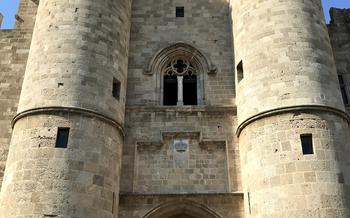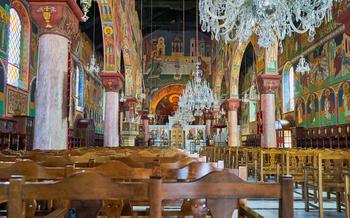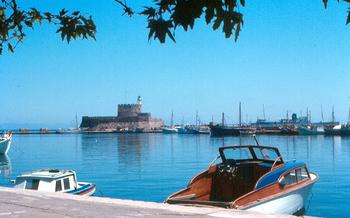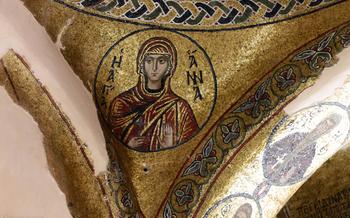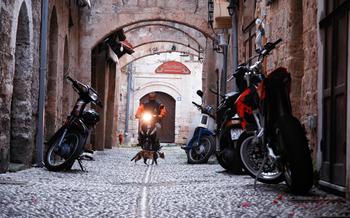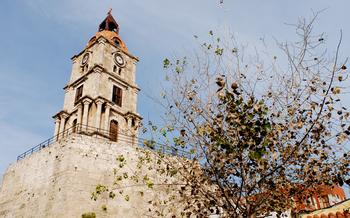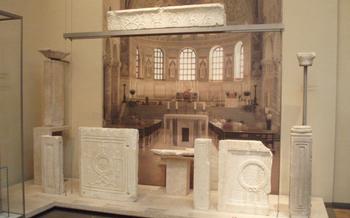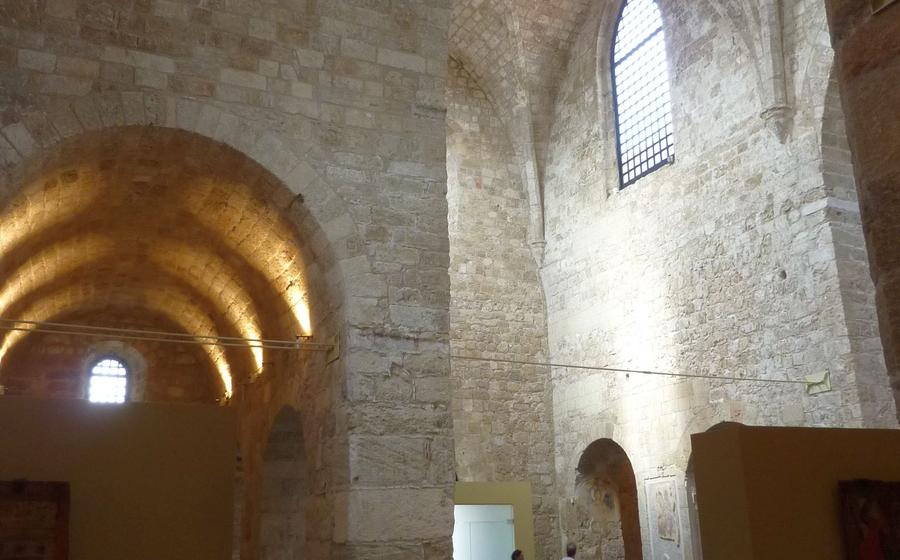
The Church of the Panagia
- The Church of the Panagia: A Spiritual Haven
- Location and Accessibility
- Hours of Operation and Admission
- Historical Significance
- Architectural Masterpiece
- Religious Iconography
- Local Traditions and Customs
- Ceremonies and Rituals
- Spiritual Retreat and Reflection
- Community Center
- Photography and Videography
- Historical Context
- Preservation and Conservation
- Educational Programs
- Insider Tip: Unveiling Hidden Treasures
The Church of the Panagia: A Spiritual Haven
The Church of the Panagia, also known as the Church of Our Lady of the Assumption, is a significant religious and historical landmark in Rhodes, Greece. Its origins can be traced back to the Byzantine era, and it has played a pivotal role in the spiritual and cultural life of the island throughout the centuries. This revered church, dedicated to the Virgin Mary, stands as a testament to the deep faith and devotion of the local community.
The Church of the Panagia exhibits a remarkable architectural style that blends Byzantine and Gothic elements, showcasing intricate stonework, graceful arches, and a majestic bell tower. The interior of the church is adorned with stunning frescoes, mosaics, and iconography that depict biblical scenes and saints, creating a truly awe-inspiring atmosphere for worship and contemplation.
Location and Accessibility
The Church of the Panagia stands proudly in the heart of Rhodes Old Town, a designated UNESCO World Heritage Site. Its exact address is Plateia Iroon Polytechniou, Rhodes Town 851 00, Greece. To reach the church, visitors can take a leisurely stroll through the enchanting cobblestone streets of the Old Town, admiring the medieval architecture and vibrant atmosphere.
For those arriving by public transportation, the closest bus stop is "Old Town", located just a short walk from the church. Alternatively, visitors can take a taxi or rent a bicycle to explore the town at their own pace.
Although the church is situated in a pedestrianized area, limited parking options are available nearby. Visitors are advised to park their vehicles in designated parking zones and walk the remaining distance to the church.
The Church of the Panagia is wheelchair accessible, ensuring that all visitors can experience its spiritual beauty and rich history. Accessibility ramps and designated seating areas are available to accommodate individuals with disabilities.
Hours of Operation and Admission
The Church of the Panagia welcomes visitors with open arms during specific hours of operation. Its doors are typically open from 8:00 AM to noon, and then again from 4:00 PM to 6:00 PM, seven days a week. However, it is advisable to check the official church website or contact local authorities for any potential variations in these hours, especially during holidays or special events.
Admission to the church is free of charge, as it is a place of worship and spirituality. Visitors are encouraged to make a donation if they wish to support the church's upkeep and maintenance. Guided tours are available upon request and are conducted by knowledgeable guides who can provide insights into the church's history, architecture, and religious significance. Visitors can also explore the church at their own pace, immersing themselves in its serene atmosphere and taking in its beauty and grandeur.
Historical Significance
The Church of the Panagia boasts a rich historical legacy that dates back to the Byzantine Empire. Constructed during the 11th century, it served as a pivotal religious and cultural center throughout Rhodes' history. Initially dedicated to the Dormition of the Theotokos, the church underwent various renovations and expansions over the centuries, reflecting the evolving architectural styles and influences of different eras.
During the era of the Knights of St. John, the church was modified to accommodate their Gothic aesthetic, resulting in the addition of pointed arches and ribbed vaults. Following the Ottoman conquest, the church underwent further transformations, including the construction of a minaret and the incorporation of Islamic elements. These architectural remnants from distinct periods narrate the intricate tapestry of Rhodes' past, showcasing the harmonious coexistence of diverse civilizations.
The church's strategic location within the Old Town of Rhodes further underscores its historical significance. Situated in the heart of the medieval city, it stands as a testament to the vibrant religious life that once permeated Rhodes' urban fabric.
Today, the Church of the Panagia serves as a living monument, embodying the cultural and spiritual heritage of Rhodes. Its enduring presence continues to inspire awe and reverence among visitors, inviting them to delve into the rich history that unfolds within its sacred walls.
Architectural Masterpiece
The Church of the Panagia stands as a testament to the enduring legacy of Byzantine architecture. Its exterior is a symphony of domes, arches, and a majestic bell tower that pierces the sky. Each dome is intricately adorned with vibrant mosaics, creating a breathtaking celestial panorama. The arches, supported by slender columns, exude an air of grace and elegance, guiding visitors towards the church's sacred interior. The bell tower, with its intricate carvings and arched windows, serves as a beacon of faith, calling the faithful to worship and contemplation.
Stepping inside the church, visitors are greeted by an awe-inspiring sanctuary adorned with frescoes, mosaics, and iconography that narrate stories from the Bible and the lives of saints. The walls are adorned with intricate paintings depicting scenes of religious devotion, while the ceiling is a kaleidoscope of colorful mosaics that seem to dance in the flickering candlelight. The iconostasis, a beautifully carved screen that separates the sanctuary from the nave, is a masterpiece in itself, featuring exquisite icons of Christ, the Virgin Mary, and various saints. Each icon is a testament to the skill and artistry of the Byzantine craftsmen who created them, capturing the essence and devotion of the Orthodox Christian faith.
Religious Iconography
In Orthodox Christianity, iconography holds immense significance as a visual representation of faith. The Church of the Panagia is adorned with a multitude of icons, each possessing unique symbolism and contributing to the spiritual atmosphere of the church.
Upon entering, visitors are greeted by the icon of the Panagia, or Virgin Mary, holding the infant Jesus. This icon, known as the Panagia of Rhodes, is the most revered in the church and is believed to have miraculous powers.
Throughout the church, visitors will find icons depicting scenes from the Bible, the lives of saints, and significant events in the history of the church. These icons are not mere decorations but serve as a means of communication between the faithful and the divine.
One of the most striking icons is that of the Last Supper, which portrays Jesus sharing his final meal with his disciples. The icon is a powerful reminder of the sacrifice and love that lie at the heart of Christianity.
Another notable icon is that of the Crucifixion, which depicts the suffering and death of Jesus on the cross. This icon evokes a sense of compassion and reverence, reminding believers of the ultimate price paid for their salvation.
Local Traditions and Customs
The Church of the Panagia is deeply entwined with the local traditions and customs of Rhodes. Throughout the year, the church plays host to a variety of special religious festivals and celebrations that draw worshippers and visitors alike. One of the most notable events is the annual feast day of the Virgin Mary, celebrated on August 15th. On this day, a grand procession takes place, carrying a revered icon of the Virgin Mary through the streets of Rhodes Town, accompanied by music, dancing, and traditional costumes. The procession culminates in a festive gathering at the church, where prayers, hymns, and offerings are made to honor the Virgin Mary.
Beyond religious festivals, the church also serves as a venue for various cultural events that showcase the rich heritage of Rhodes. Traditional dance performances, concerts, and exhibitions are often held within the church's premises, providing a platform for local artists and performers to share their talents with the community. These events offer visitors a glimpse into the vibrant cultural traditions that have been passed down through generations in Rhodes.
Ceremonies and Rituals
The Church of the Panagia is a living and active place of worship, and visitors are welcome to attend religious services and ceremonies. The most important ceremony is the Divine Liturgy, which is held every Sunday and on major feast days. The Divine Liturgy is a beautiful and moving service that includes prayers, hymns, readings from the Bible, and the Eucharist. Other regular services include Matins, Vespers, and Compline.
Visitors are welcome to participate in the services, but it is important to be respectful of the customs and traditions of the Orthodox Church. For example, women should cover their heads with a scarf or hat, and men should remove their hats. It is also important to be quiet and reverent during the services.
In addition to the regular services, the Church of the Panagia also hosts a variety of special events and festivals throughout the year. These events include processions, concerts, and exhibitions. Visitors are encouraged to check the church's website or contact the church office for more information on upcoming events.
Spiritual Retreat and Reflection
The Church of the Panagia offers a serene and sacred space for spiritual retreat and reflection. Its tranquil atmosphere, beautiful iconography, and rich history create an environment conducive to meditation, prayer, and contemplation. Visitors can find solace and inspiration within the church's hallowed walls, away from the hustle and bustle of everyday life. Whether seeking a moment of quiet reflection or a deeper spiritual connection, the church provides a sanctuary for those seeking solace and inner peace.
Community Center
Beyond its religious significance, the Church of the Panagia serves as a vibrant community center for the local residents of Rhodes. It hosts a multitude of social and cultural events throughout the year, providing a space for people to connect, celebrate, and preserve their cherished traditions.
Religious festivals, such as the annual feast day of the Panagia, bring the community together for joyous celebrations. These festivals showcase traditional music, dance, and food, creating a festive atmosphere that draws both locals and visitors alike.
The church also plays a vital role in community outreach programs and initiatives. It organizes charity events, supports educational programs, and provides assistance to those in need. By actively engaging with the community, the Church of the Panagia reinforces its role as a pillar of support and a beacon of hope for the people of Rhodes.
Visitors to the church are welcome to participate in these community events and experience firsthand the warmth and hospitality of the local people. It is an opportunity to immerse oneself in the rich cultural tapestry of Rhodes and gain a deeper appreciation for the community spirit that thrives within the walls of this sacred space.
Photography and Videography
Capturing the beauty and spirituality of the Church of the Panagia through photography or videography is a wonderful way to preserve your memories and share the church's unique atmosphere with others. However, it is important to be respectful of the sacred nature of the space and follow certain guidelines.
Photography and videography are generally permitted inside the church, but there may be restrictions in certain areas, such as the altar or during religious services. It's always advisable to ask for permission before taking any photos or videos, especially if there is an ongoing ceremony or event.
Using flash or tripods during religious services is generally not allowed, as it can be disruptive. It's best to use natural light or low-light photography techniques to capture the church's interior without disturbing the worshippers.
When taking photos or videos, be mindful of the privacy of other visitors and avoid capturing their faces or personal details without their consent. It's also important to maintain a respectful distance from the icons and other sacred objects within the church.
By following these guidelines, you can ensure that your photography or videography experience at the Church of the Panagia is both enjoyable and respectful of the sacred space and its visitors.
Historical Context
The Church of the Panagia is deeply intertwined with the rich tapestry of Rhodes' history. Its construction during the Byzantine Empire in the 11th century reflects the island's significant role as a strategic outpost and a crossroads of cultures. The church served as a spiritual center for the local Orthodox Christian community and witnessed the island's many transformations over the centuries. It survived the tumultuous period of Ottoman rule, retaining its religious significance while absorbing architectural influences from different eras. The church's resilience and enduring presence make it a testament to the enduring spirit of Rhodes and its people.
Its location within the medieval city walls highlights its role in the defense and fortification of Rhodes. The church's proximity to the Palace of the Grand Master and other important historical sites underscores its significance as a religious and cultural landmark. Over the years, the Church of the Panagia has witnessed significant historical events, from the arrival of the Knights of St. John in the 14th century to the island's transition to modern Greece in the early 20th century. Its enduring presence serves as a reminder of Rhodes' complex and fascinating past.
Preservation and Conservation
The Church of the Panagia has undergone several preservation and conservation efforts to maintain its historical and architectural integrity. These initiatives are crucial to ensuring that this sacred site remains a testament to Rhodes' rich past for generations to come.
One of the challenges faced in preserving the church is the natural wear and tear caused by time and environmental factors. The church's exterior, exposed to the elements, requires regular maintenance to prevent deterioration. Skilled artisans and conservators employ traditional techniques to restore damaged stonework, frescoes, and mosaics, ensuring that the church retains its original beauty and grandeur.
The community plays a vital role in preserving the church's heritage. Local residents and volunteers participate in fundraising initiatives, awareness campaigns, and clean-up efforts to support the church's upkeep. The church's significance as a cultural and religious landmark encourages a sense of collective responsibility among the community members, who are dedicated to safeguarding this cherished symbol of their history.
Visitors to the church are also encouraged to contribute to its preservation by respecting the site and adhering to guidelines for responsible tourism. This includes avoiding touching or damaging the frescoes and mosaics, maintaining a respectful silence during religious services, and refraining from using flash photography, which can harm delicate artifacts.
Through the combined efforts of the community, conservators, and responsible visitors, the Church of the Panagia continues to stand as a testament to Rhodes' rich history and religious heritage, ensuring that its spiritual and cultural significance endures for generations to come.
Educational Programs
The Church of the Panagia offers a range of educational programs and guided tours designed to enhance visitors' understanding and appreciation of its history, architecture, and religious significance. These programs are led by knowledgeable guides who provide insights into the church's unique features, symbolism, and role in the local community.
Guided tours are available in various languages and can be booked in advance to ensure a spot. Fees for guided tours are typically nominal and often include admission to the church. Group discounts may also be available for larger groups or educational institutions.
The educational programs cover a wide range of topics, including the church's Byzantine architectural style, its rich iconography, and its role in religious and cultural life throughout history. Visitors will learn about the symbolism behind the church's design, the stories and legends associated with its icons, and the rituals and ceremonies that take place within its walls.
These educational programs are an excellent way for visitors to gain a deeper understanding of the Church of the Panagia and its significance in Rhodes. Whether you are a history buff, an architecture enthusiast, or simply someone seeking spiritual enlightenment, these programs offer a unique and enriching experience.
Insider Tip: Unveiling Hidden Treasures
Beyond the well-known attractions of the Church of the Panagia, there lie hidden gems waiting to be discovered by curious travelers. One such treasure is the church's hidden crypt, accessible through a discreet entrance near the altar. Descend the stone steps to discover a subterranean chamber adorned with ancient frescoes and intricate carvings, offering a glimpse into the church's rich past.
For those seeking a unique spiritual experience, consider attending one of the church's special candlelight services held during major religious festivals. As the church's interior is illuminated by flickering candlelight, visitors can immerse themselves in a deeply moving and atmospheric ceremony.
To combine your visit with other nearby attractions, take a leisurely stroll through the picturesque Old Town of Rhodes, a UNESCO World Heritage Site. Explore its charming cobblestone streets, admire the medieval architecture, and soak in the vibrant atmosphere of this historic neighborhood.
For an unforgettable experience, plan your visit to coincide with the annual Feast of the Assumption, held on August 15th. During this grand celebration, the church becomes the focal point of processions, traditional dances, and lively festivities, offering a glimpse into the vibrant religious and cultural traditions of Rhodes.
